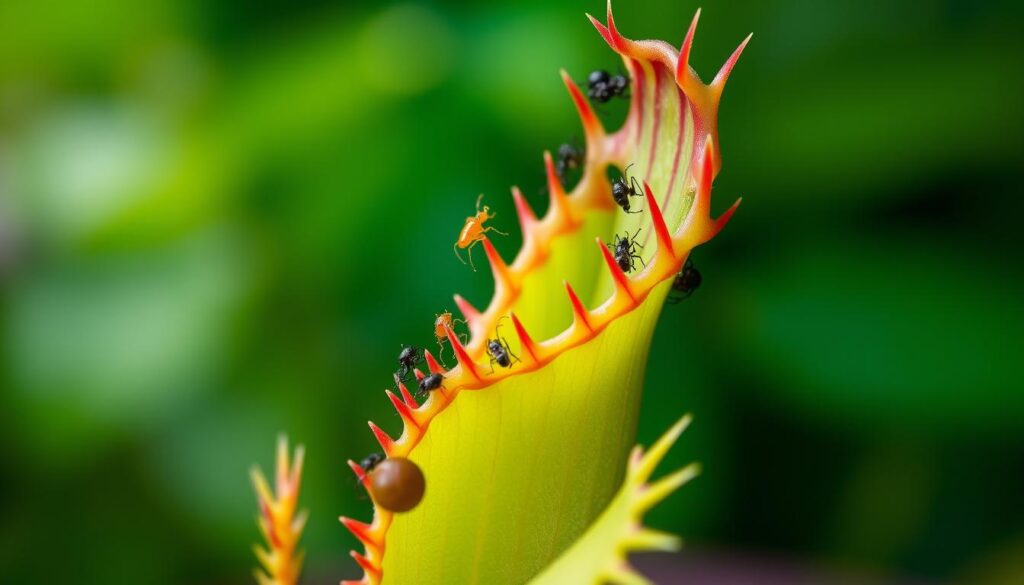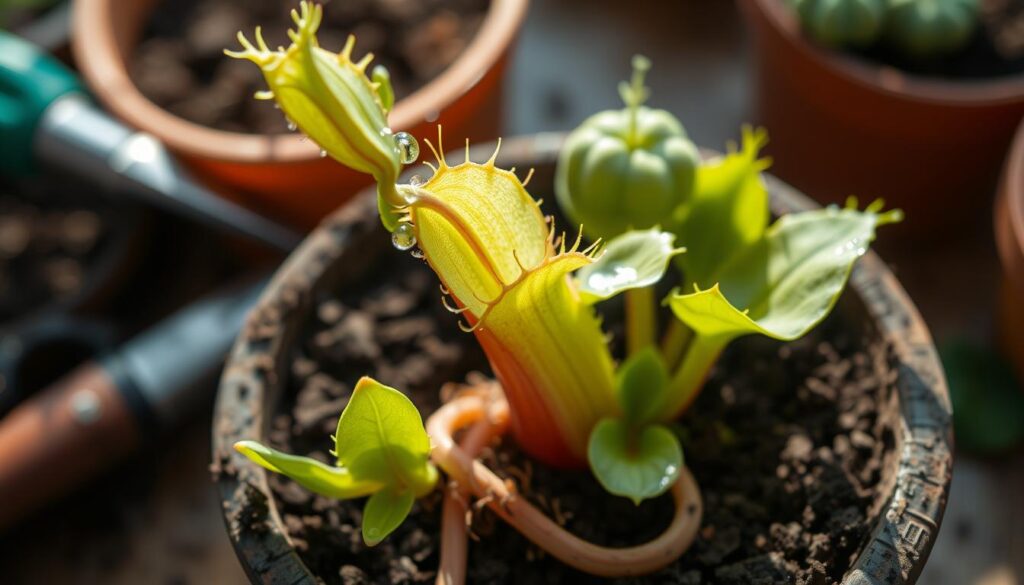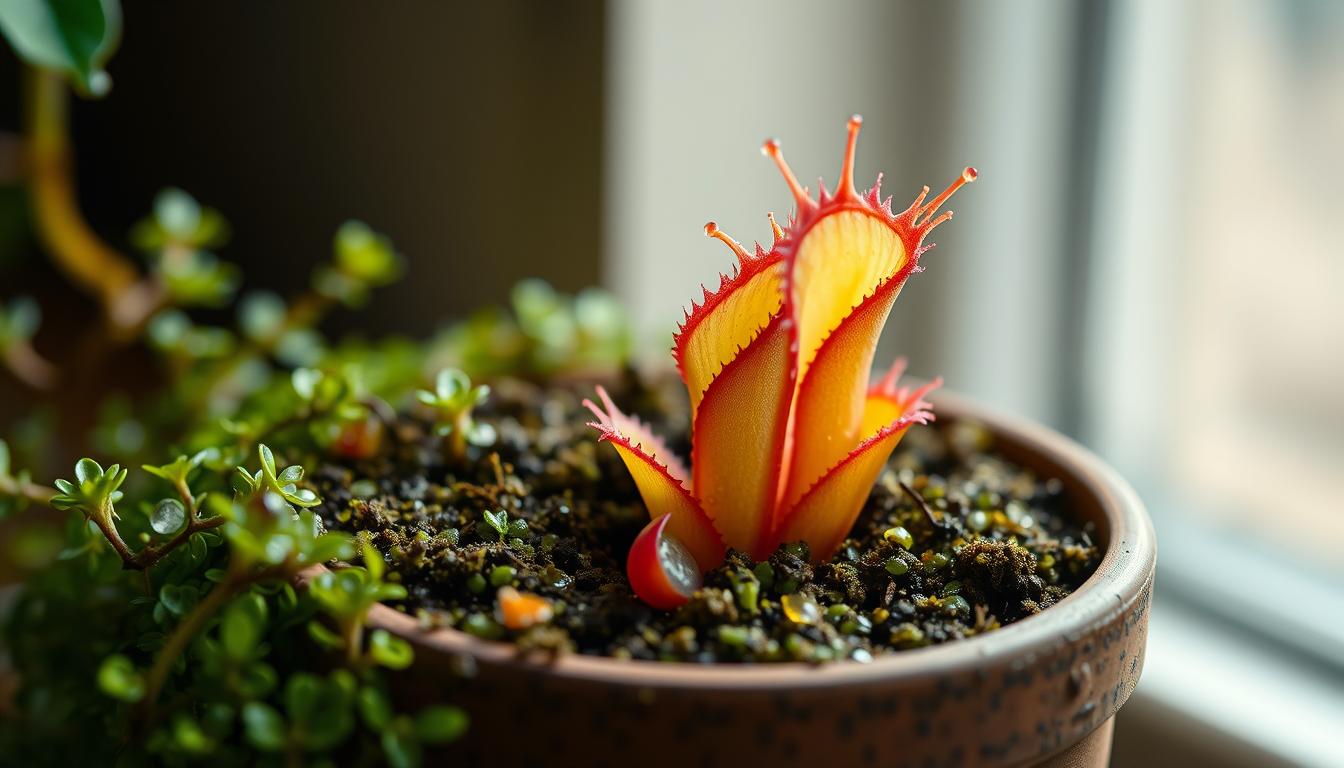Think you don’t have room for houseplants? Think again! Even the tiniest spaces can come to life with the right greenery. A Venus flytrap is a great example of this. These plants are perfect for small apartments, dorm rooms, or adding a touch of nature to your desk or shelves.
Key Takeaways
- Venus flytraps are easy to care for, making them great for small spaces.
- They are carnivorous plants that catch and digest insects for nutrients.
- They need high humidity and poor, acidic soil to thrive.
- They require pure water and consistent moisture to grow well.
- Venus flytraps can grow in small pots, making them ideal for indoor gardening.
- They need cold winter dormancy and are sensitive to temperature changes.
- Following the right care guidelines can make your Venus flytrap a unique and fascinating houseplant.
Understanding the Venus Flytrap’s Unique Nature
The Venus flytrap is very interesting. It has 4-7 hinged leaves. Each leaf has trigger hairs that catch insects.
When an insect lands and touches two hairs, the leaf snaps shut. This traps the insect inside.
Tom Bennet said the Venus flytrap uses sweet nectar to catch prey. Then, it digests the insects for food. This helps the plant grow well in poor soil.
- Use distilled or rainwater to water the plant. Tap water can harm it.
- Keep the humidity high, between 60-80%.
- Give it about 12 hours of sunlight each day.
- Feed it live insects during the growing season.
By knowing how to care for the Venus flytrap, you can enjoy its beauty. It’s a truly amazing carnivorous plant.
Ideal Growing Conditions for Your Venus Flytrap
For venus flytrap care, the right environment is key. You need the right venus flytrap soil mix. This should be a mix of sphagnum peat moss and lime-free sand or perlite.
The soil must be acidic and hold moisture well. This helps the roots grow strong.
Lighting is also crucial for your venus flytrap sunlight. Direct sunlight is best. But, remember to keep the temperature and humidity right too.
A temperature of 65-85°F (18-30°C) and high humidity are best. This makes your venus flytrap happy and healthy.
- Watering: Use distilled water to avoid nutrient build-up.
- Feeding: Feed your venus flytrap with live insects every two weeks.
- Pest control: Check for pests like aphids and fungus gnats, and take action if necessary.
With the right soil, sunlight, and care, your venus flytrap will thrive. Enjoy its unique, carnivorous nature.
Watering Your Venus Flytrap: Best Practices
Watering your venus flytrap is key to its health. You need to give it the right amount of water. The best way is to put the pot in about 1 cm of water.
Don’t water from the top. Use pure water like rainwater or distilled water instead. This keeps the soil clean.
Tap water is bad for your venus flytrap. It has too much sodium, calcium, and magnesium. Pure water stops these minerals from building up in the soil.
Check the soil moisture often. It should be moist but not too wet. Use a moisture meter or soil probe to check.
By following these tips, your venus flytrap will thrive. It will grow strong and healthy.
Feeding Your Venus Flytrap: A Guide
Your Venus flytrap needs a special diet to grow well. It’s key to give it the right food for growth. Knowing what your plant needs is part of caring for it.
Tom Bennet says feeding your Venus flytrap with insects is great. You can use mealworms, bloodworms, or crickets. Make sure they’re not too big for the trap.
Here are some tips for feeding your Venus flytrap:
- Feed your plant once a week, using one or two traps per Venus flytrap for maximum growth rate.
- Use distilled water to prevent mineral buildup in the soil.
- Maintain a temperature increase to between 24°C (75°F) and 28°C (82°F) for 48 hours after each feeding session.
By following these tips, you can give your Venus flytrap the best care. Always learn about your plant’s needs for it to grow well.
Potting Your Venus Flytrap
Potting is key for venus flytrap care. The right pot lets roots grow and soil drain well. Choose a pot with holes in the bottom, like plastic or ceramic.
Use a special soil mix for carnivorous plants. A mix of peat moss and perlite is best. It keeps the soil moist but airy. Don’t use regular potting soil, as it can harm your plant.
Repot your venus flytrap every year for healthy growth. Spring or early summer is the best time. Handle the roots carefully and fill the pot with enough soil.
Make sure the pot is at least 4 inches deep. This helps keep the roots warm. Also, keep at least 2 inches of soil around the rhizomes for insulation.
Some important tips for repotting include:
- Water with pure water, like filtered or rainwater, after repotting. This keeps the plant clean.
- Don’t repot when your plant is flowering. It can stress the plant out.
- After repotting, your plant might grow slower for 1 to 2 weeks. This is normal.
By following these tips and using the right soil, your venus flytrap will thrive. Enjoy the special care it needs.
Common Challenges in Venus Flytrap Care
When you start caring for Venus flytraps, you’ll face some challenges. These can affect your plant’s health. One big problem is venus flytrap pests like aphids and spider mites. They can really harm your plant.
Disease prevention is another big challenge. Fungal diseases like powdery mildew can hurt your Venus flytrap. Look for white spots or yellow leaves. Then, take action to stop it from spreading. Good venus flytrap care helps prevent these problems.

Environmental stress is also a problem. Wrong watering and not enough light can harm your plant. Wilting leaves mean too much water. Not enough growth means not enough water. Knowing these issues helps you care for your Venus flytrap better.
Some common problems include:
- Yellowing leaves, which can indicate stress or nutrient deficiencies
- Fuzzy growth, which can be a sign of fungal problems
- A significant reduction in traps or lack of new growth, which can be a sign of environmental stress
By knowing these issues and preventing them, you can give your Venus flytrap the best care. This way, you can enjoy its unique and fascinating nature.
Seasonal Care Tips for Your Venus Flytrap
As you keep up with the best venus flytrap care, remember the seasons change. In summer, your plant loves full sun. It needs at least six hours of direct light every day. But when winter comes, your plant must go into venus flytrap dormancy.
To get your plant ready for dormancy, make it cooler. Keep it between 50°F to 60°F. Also, water it less. You can add mulch to keep it safe from cold winds.
Here are some winter tips:
- Keep the soil moist but not soggy
- Reduce watering frequency
- Provide cooler temperatures, ideally between 40°F to 55°F
Follow these tips for the best venus flytrap care. Your plant will do great during winter venus flytrap dormancy.
| Season | Care Tips |
|---|---|
| Summer | Provide full sun, maintain high humidity |
| Winter | Provide cooler temperatures, reduce watering frequency |
Growing Venus Flytraps Indoors vs. Outdoors
Choosing where to grow your Venus flytrap is key. You can grow it indoors or outdoors. Each choice has its own benefits and drawbacks.
Outdoor growth lets your plant get natural sunlight and humidity. But, it might attract pests and diseases. Indoor growth lets you control the environment better. Yet, it might not have enough natural light and humidity.
Pros and Cons of Indoor Cultivation
Indoor growth has some good points:
- Control over temperature and humidity
- Protection from pests and diseases
- Year-round growth and flowering
But, there are downsides too:
- Lack of natural light
- Higher risk of overwatering
- Less humidity
Outdoor Care Considerations
Outdoor care needs careful thought. Your plant needs at least 6 hours of direct sunlight daily. Soil temperature must be watched to avoid overheating. Also, protect your plant from frost and extreme temperatures.
Whether to grow indoors or outdoors depends on your situation. Know the pros and cons of each. With the right care, your Venus flytrap will thrive and amaze you.
| Location | Pros | Cons |
|---|---|---|
| Indoors | Control over environment, protection from pests and diseases | Lack of natural light, higher risk of overwatering |
| Outdoors | Natural light and humidity, year-round growth and flowering | Pests and diseases, extreme temperatures |
Propagating Your Venus Flytrap
Exploring venus flytrap propagation is exciting. You can share plants with friends or grow more. To do it right, you need to know the methods and when to do them. Carnivorous plant care is all about details, and so is propagation.
There are two main ways to grow Venus flytraps: sexual and vegetative. Sexual propagation uses seeds from the flower stalk. Each seed pod has 20 to 30 seeds. They start to lose their power after 100 days. Vegetative propagation means dividing or cutting the plant to make new ones.

- Seeds start to grow in 15 to 30 days after planting
- Vegetative methods can make mature plants in 1 to 2 years
- Healthy leaf pullings have a 75% success rate or more
Knowing these tips can help you grow more Venus flytraps. Make sure to give them the right carnivorous plant care. This includes enough light, water, and food for them to thrive.
Understanding Venus Flytrap Lifespan
As you keep giving your Venus Flytrap the best venus flytrap care, it’s key to know its lifespan. The leaves and traps of a Venus Flytrap don’t last forever. This helps you know what to expect and how to care for it better.
Every leaf and trap can live for months. But they will die and new ones will grow. This is just how the plant lives. Watching your plant’s health and changing your care as needed is important.
Things like how well you care for it, its home, and its genes can change its lifespan. Giving it the right light, water, and food helps it live longer.
Here are signs your Venus Flytrap is getting old:
- Yellowing or browning of the leaves
- Reduced trap functionality
- Slower growth rate
Knowing your Venus Flytrap’s lifespan and aging signs helps you care for it better. With the right venus flytrap care, it can live for years. You’ll get to enjoy its cool features for a long time.
Connecting with Fellow Venus Flytrap Enthusiasts
Exploring venus flytrap care can be fun with friends. The carnivorous plant community loves these plants a lot. Online forums and groups are full of helpful tips and stories.
Check out online resources for tips on venus flytrap care. You can also join local plant clubs. There, you’ll meet people who love plants just like you.
Being part of the carnivorous plant community has many perks. You get:
- Expert advice
- A chance to share your own stories
- News on the latest plant care
- Friends who love plants as much as you do
Joining the venus flytrap care group can make you better at growing plants. So, start making friends today. You’ll find a supportive and fun community.
| Community Resource | Description |
|---|---|
| Online Forums | A place to meet others, ask questions, and share stories |
| Local Plant Clubs | Meetups where you can meet people and learn from their experiences |
| Social Media Groups | Groups online where you can share knowledge and stay updated |
Benefits of Growing a Venus Flytrap at Home
Getting a Venus flytrap for your home is exciting. It brings a unique plant to your space. It also helps keep pests away without using harmful chemicals.
Watching how it eats can be calming. It makes you feel better.
Venus flytraps eat insects like ants and flies. They help keep your home balanced. They need very little care, making them great for anyone.
They also make the air in your home better. They sit in water, which makes the air feel fresher. Plus, they’re a great topic to talk about with friends.
If you would like to see other popular plants in the compact space category, check out our article of 10 perfect houseplants for compact spaces.




Pingback: The Ultimate Guide to Houseplants: 100 Best Indoor Plants for Every Home - Trusted House Plant Guide